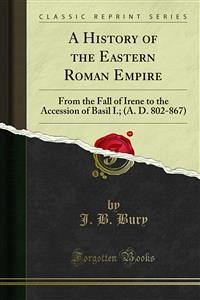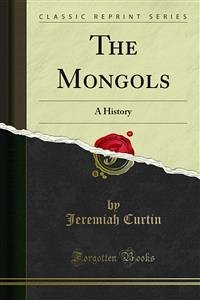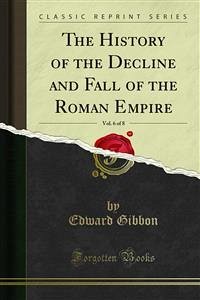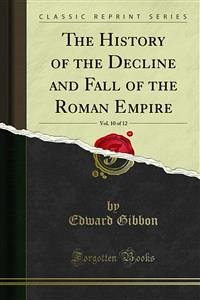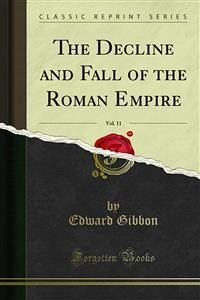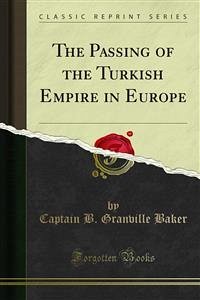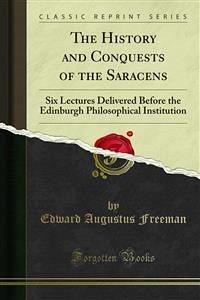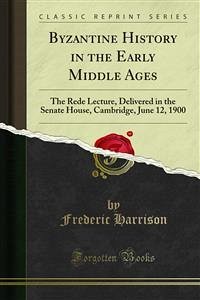J. B. Bury
A History of the Eastern Roman Empire (eBook, PDF)
From the Fall of Irene to the Accession of Basil I.; (A. D. 802-867)
10,85 €
inkl. MwSt.
Sofort per Download lieferbar

0 °P sammeln
J. B. Bury
A History of the Eastern Roman Empire (eBook, PDF)
From the Fall of Irene to the Accession of Basil I.; (A. D. 802-867)
- Format: PDF
- Merkliste
- Auf die Merkliste
- Bewerten Bewerten
- Teilen
- Produkt teilen
- Produkterinnerung
- Produkterinnerung

Bitte loggen Sie sich zunächst in Ihr Kundenkonto ein oder registrieren Sie sich bei
bücher.de, um das eBook-Abo tolino select nutzen zu können.
Hier können Sie sich einloggen
Hier können Sie sich einloggen
Sie sind bereits eingeloggt. Klicken Sie auf 2. tolino select Abo, um fortzufahren.

Bitte loggen Sie sich zunächst in Ihr Kundenkonto ein oder registrieren Sie sich bei bücher.de, um das eBook-Abo tolino select nutzen zu können.
- Geräte: PC
- ohne Kopierschutz
- eBook Hilfe
- Größe: 39.05MB
- Upload möglich
Andere Kunden interessierten sich auch für
![The Mongols (eBook, PDF) The Mongols (eBook, PDF)]() Jeremiah CurtinThe Mongols (eBook, PDF)9,85 €
Jeremiah CurtinThe Mongols (eBook, PDF)9,85 €![The History of the Decline and Fall of the Roman Empire (eBook, PDF) The History of the Decline and Fall of the Roman Empire (eBook, PDF)]() Edward GibbonThe History of the Decline and Fall of the Roman Empire (eBook, PDF)9,85 €
Edward GibbonThe History of the Decline and Fall of the Roman Empire (eBook, PDF)9,85 €![The History of the Decline and Fall of the Roman Empire (eBook, PDF) The History of the Decline and Fall of the Roman Empire (eBook, PDF)]() Edward GibbonThe History of the Decline and Fall of the Roman Empire (eBook, PDF)8,85 €
Edward GibbonThe History of the Decline and Fall of the Roman Empire (eBook, PDF)8,85 €![The Decline and Fall of the Roman Empire (eBook, PDF) The Decline and Fall of the Roman Empire (eBook, PDF)]() Edward GibbonThe Decline and Fall of the Roman Empire (eBook, PDF)8,85 €
Edward GibbonThe Decline and Fall of the Roman Empire (eBook, PDF)8,85 €![The Passing of the Turkish Empire in Europe (eBook, PDF) The Passing of the Turkish Empire in Europe (eBook, PDF)]() Captain B. Granville BakerThe Passing of the Turkish Empire in Europe (eBook, PDF)8,85 €
Captain B. Granville BakerThe Passing of the Turkish Empire in Europe (eBook, PDF)8,85 €![The History and Conquests of the Saracens (eBook, PDF) The History and Conquests of the Saracens (eBook, PDF)]() Edward Augustus FreemanThe History and Conquests of the Saracens (eBook, PDF)7,85 €
Edward Augustus FreemanThe History and Conquests of the Saracens (eBook, PDF)7,85 €![Byzantine History in the Early Middle Ages (eBook, PDF) Byzantine History in the Early Middle Ages (eBook, PDF)]() Frederic HarrisonByzantine History in the Early Middle Ages (eBook, PDF)5,85 €
Frederic HarrisonByzantine History in the Early Middle Ages (eBook, PDF)5,85 €-
-
-
Produktdetails
- Verlag: Forgotten Books
- Erscheinungstermin: 21. Oktober 2017
- Englisch
- ISBN-13: 9780243692149
- Artikelnr.: 59070646
- Herstellerkennzeichnung Die Herstellerinformationen sind derzeit nicht verfügbar.
John Bagnell Bury, FBA, was an Anglo-Irish historian, classical scholar, medieval Roman historian, and philologist. He clearly rejected the title "Byzantinist" in the preface to the 1889 edition of his Later Roman Empire. He was Erasmus Smith's Professor of Modern History at Trinity College Dublin from 1893 to 1902, then Regius Professor of Modern History at the University of Cambridge and a Professorial Fellow of King's College, Cambridge from 1902 until his death. Bury was born in Clontibret, County Monaghan, in 1861 as the son of Edward John Bury and Anna Rogers. His father was the Rector of the Anglican Church of Ireland. He was first educated by his parents before attending Foyle College in Derry. He was 24 years old when he was elected a fellow of Trinity College Dublin in 1885. That same year, he married his second cousin Jane Bury, who helped him with his work, particularly her chapter on Byzantine art in the History of the Later Roman Empire (1889); they had one son. In 1893, he was appointed to Trinity College's Erasmus Smith's Chair of Modern History, where he served for nine years. In 1898, he was named Regius Professor of Greek at Trinity, a position he maintained alongside his history professorship.[4] In late 1902, he became Regius Professor of Modern History at the University of Cambridge.
1. Nicephorus I, Stauracius, and Michael I (AD 801-813)
2. Leo V, the Armenian, and the revival of iconoclasm (AD 813-820)
3. Michael II, the Amorian (AD 820-829)
4. Theophilus (AD 829-842)
5. Michael III (AD 842-867)
6. Photius and Ignatius
7. Financial and military administration
8. The Saracen wars
9. The Saracen conquests of Crete and Sicily
10. Relations with the western empire. Venice
11. Bulgaria
12. The conversion of Slavs and Bulgarians
13. The empire of the Khazars and the peoples of the north
14. Art, learning, and education in the Amorian period
Appendices
Bibliography
Index.
2. Leo V, the Armenian, and the revival of iconoclasm (AD 813-820)
3. Michael II, the Amorian (AD 820-829)
4. Theophilus (AD 829-842)
5. Michael III (AD 842-867)
6. Photius and Ignatius
7. Financial and military administration
8. The Saracen wars
9. The Saracen conquests of Crete and Sicily
10. Relations with the western empire. Venice
11. Bulgaria
12. The conversion of Slavs and Bulgarians
13. The empire of the Khazars and the peoples of the north
14. Art, learning, and education in the Amorian period
Appendices
Bibliography
Index.
1. Nicephorus I, Stauracius, and Michael I (AD 801-813)
2. Leo V, the Armenian, and the revival of iconoclasm (AD 813-820)
3. Michael II, the Amorian (AD 820-829)
4. Theophilus (AD 829-842)
5. Michael III (AD 842-867)
6. Photius and Ignatius
7. Financial and military administration
8. The Saracen wars
9. The Saracen conquests of Crete and Sicily
10. Relations with the western empire. Venice
11. Bulgaria
12. The conversion of Slavs and Bulgarians
13. The empire of the Khazars and the peoples of the north
14. Art, learning, and education in the Amorian period
Appendices
Bibliography
Index.
2. Leo V, the Armenian, and the revival of iconoclasm (AD 813-820)
3. Michael II, the Amorian (AD 820-829)
4. Theophilus (AD 829-842)
5. Michael III (AD 842-867)
6. Photius and Ignatius
7. Financial and military administration
8. The Saracen wars
9. The Saracen conquests of Crete and Sicily
10. Relations with the western empire. Venice
11. Bulgaria
12. The conversion of Slavs and Bulgarians
13. The empire of the Khazars and the peoples of the north
14. Art, learning, and education in the Amorian period
Appendices
Bibliography
Index.
